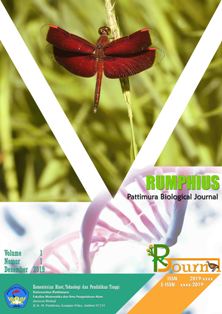FIELD GRASS SILAGE WITH THE ADDITION OF COLI FRUIT FIBER QUESTION AS RUMINANT ANIMAL FEED
Abstract
This research aims to find out what % of coli fruit fiber juice is used to produce good quality silage, and to find out the physical quality of field grass silage with the addition of coli fruit fiber juice. The materials used in this research were field grass and coli fruit fiber juice brought from Moa Island, Southwest Maluku Regency. This research will be carried out for 2 months (October-November, 2022) at the Faculty of Agriculture, Animal Husbandry Department, Pattimura University, Ambon. The harvested silage will be subject to observation and/or physical analysis of field grass silage at the Animal Nutrition and Forage Laboratory, Pattimura University, Ambon. The variables observed were color, aroma, texture, pH and the presence or absence of mold in the silage. The physical quality was tested by the 5 students selected as panelists using the questionnaire provided.
Downloads
References
Agriculture department. 1980. Silage as Animal Food. Agriculture department. Agricultural Information Center. Livestock Research Report. Ciawi, Bogo.
Directorate of Animal Feed. 2011. General Guidelines for Lumbung Development.
Gasperz, Vincent. (1995). Analysis Techniques in Experimental Research, volume 1. Bandung: Tarsito
Hynd PI. (2019). Animal Nutrition from Theory to Practice. CABI Publishers.
Kim, J. G., Li, Y. W., Ham, J., & Park, H. S. (2017). Development of a New Lactic Acid Bacterial Inoculant for Fresh Rice Straw Silage. Asian Australia. Anim Sci Journal, 30(7), 950–956.
Kojo, R., Rustandi., Tulung, Y. R., & Malalantang, S. (2015). Effect of adding rice bran & corn flour on the physical quality of elephant grass silage. Zootech Journal, 35(1), 21–29.
kurnianingtyas, I., Pandansari, P., Astuti, I., Widyawati, S., & Suorayogi, W. P. (2012). The influence of accelerator types on the physical, chemical & biological quality of Kolonjono grass silage. Tropical Animal Husbandry, 1(1), 7–14
Larangahen, A., Bagau, B., Imbar, M. R., & Liwe, H. (2017). Effect of Adding Molasses on the Physical and Chemical Quality of Shoe Banana (Mussa paradisiaca formatypica) Peel Silage. Zootek Journal (“Zootek” Journal), 37(1), 156 – 166.
Mahmud, Z., D. Alorerung and Amrizal, (1991). Prospects for Coconut, Sugar Palm, Lontar and Gewang Plants to Produce Sugar. Balitka Bulletin No.14 of 1991 Pg.90-105. Coconut Plant Research Institute, Manado.
Maulidayati. (2015). Physical Properties and Fiber Fraction of Oil Palm Frond Silage Added with Indigoferra Biomass. Thesis. Faculty of Agriculture and Animal Husbandry. Sultan Syarif Kasim Riau State Islamic University, Pekanbaru.
Mugiawati, R. E., & Suwarno, N. H. (2013). Water content and pH of elephant grass silage on the 21st day with the addition of additives and lactic acid bacteria. Journal of Scientific Animal Husbandry, 1(1), 201-207.
Prayitno, A.H., D. Pantaya & B. Prasetyo. (2020). Silage Technology Handbook. Jember State Polytechnic: Jember
Rahayu, I. D., Zalizar, L., Widianto, A., & Yulianto, M. I. (2017). Characteristics and Quality of Corn (Zea mays) Silage Using Various Levels of Fermenter Addition Containing Lignochloritic Bacteria. Proceedings of National Seminar and Product Title., Faculty of Agriculture, Animal Husbandry, Muhammadiyah University. Poor. Pp.730-737.
Sadarman., Febrina, D., Wahyono, T., Mulianda, R., Qomariyah, N., Nurfitriani, R. A., Khairi, F., Desraini, S. R., Zulkarnain., Prastyo, A. B., & Adli, D. N. (2022) . Physical quality of elephant grass silage and fresh tofu dregs with the addition of commercial discarded syrup. Journal of Nutritional Science and Feed Technology, 20(2), 73-77.
Sandi, S., Laconi, E. B., Sudarman, A., Wiryawan, K. G., & Mangundjaja, D. (2010). Nutritional quality of silage made from cassava with enzymes from cow rumen fluid and Leuconostoc mesenteroides. Livestock Media, 33(1), 25-30.
Septian FD, Kardaya, Astuti WD. (2011). Evaluation of the quality of market vegetable waste silage enriched with various additives and lactic acid bacteria. J Agric.2:117-124.
Syafi'i & Riszqina. (2017). Quality Elephant Grass Silage Using Preservatives, Rice Bran, and Cassava Flour. Maduranch, 2(2), 49-58.
Utomo, R. (2015). Conservation of Forage and Improving the Quality of High Fiber Feed Ingredients. 1st printing. Gadjah Mada University Press, Yogyakarta.
Wati, S. W., Mashudi & Irsyammawati, A. (2018). Quality of Odot Grass Silage (Pennisetum purpureum cv. mott) With the Addition of Lactobacillus Plantarum and Molasses at Different Incubation Times. Journal of Tropical Animal Nutrition, 1(1), 45 – 53.
Wattiaux. (2013). Introduction to Silage Making. Dairy Updates: Feeding, 502, 1–12.
Zakariah, A. (2016). Potential of Cocoa Fruit Shell as Ruminant Animal Feed. Almaida Library: Makasar.
Authors who propose a manuscript and have it approved for publication know that the manuscript will be registered and become part of the RPBJ. Authors and readers understand that this journal is open and all its contents can be accessed freely, provided that RPBJ is still listed as the source of information. The hope is that this journal can become a vehicle for exchange and scientific knowledge for society and the scientific community, especially in the field of Biology and other branches of science.









